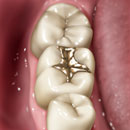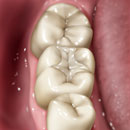A filling is a way to restore a tooth damaged by decay back to its normal function and shape. When a dentist gives you a filling, he or she first removes the decayed tooth material, cleans the affected area, and then fills the cleaned out cavity with a filling material.
By closing off spaces where bacteria can enter, a filling also helps prevent further decay. Materials used for fillings include gold, porcelain, a composite resin (tooth-colored fillings), and an amalgam (an alloy of mercury, silver, copper, tin and sometimes zinc).
No one type of filling is best for everyone. What's right for you will be determined by the extent of the repair, whether you have allergies to certain materials, where in your mouth the filling is needed, and the cost. Considerations for different materials include:
- Amalgam (silver) they are more noticeable than porcelain or composite restorations and are not usually used in very visible areas, such as front teeth.
- Composite (plastic) resins are matched to be the same color as your teeth and therefore used where a natural appearance is desired. The ingredients are mixed and placed directly into the cavity, where they harden. Composites may not be the ideal material for large fillings as they may chip or wear over time. They can also become stained from coffee, tea or tobacco, and do not last as long as other types of fillings generally from three to 10 years.
- Porcelain fillings are called inlays or onlays and are produced by ordering in a lab and then bonded to the tooth. They can be matched to the color of the tooth and resist staining. A porcelain restoration generally covers most of the tooth. Their cost is similar to gold.
If decay or a fracture has damaged a large portion of the tooth, a crown, or cap, may be recommended. Decay that has reached the nerve may be treated in two ways: through root canal therapy (in which nerve damaged nerve is removed) or through a procedure called pulp capping (which attempts to keep the nerve alive).
How Do I Know if I Need a Filling?
It looks abnormal will then be closely checked with special instruments. Your dentist may also took radiograph of your entire mouth or a section of it. The type of treatment your dentist chooses will depend on the extent of damage caused by decay.
 |
 |
 |
| Silver amalgam | Gold filling | White filling (composite) |
A dental implant is an artificial tooth root used in dentistry to support restorations that resemble a tooth or group of teeth. Dental implants can be used to support a number of dental prostheses, including crowns, implant-supported bridges or dentures. Dental implant success is related to operator skill, quality and quantity of the bone available at the site, and the patient's oral hygiene. The general consensus of opinion is that implants carry a success rate of around 95%.
Some factors increase the risk of developing periodontal disease:
- Tobacco smoking or chewing
- Systemic diseases such as diabetes
- Some types of medication such as steroids, some types of anti-epilepsy drugs, cancer therapy drugs, some calcium channel blockers and oral contraceptives
- Bridges that no longer fit properly
- Crooked teeth
- Fillings that have become defective
- Pregnancy or use of oral contraceptives

Several warning signs that can signal a problem:
- Gums that bleed easily
- Red, swollen, tender gums
- Gums that have pulled away from the teeth
- Persistent bad breath or bad taste
- Permanent teeth that are loose or separating
- Any change in the way your teeth fit together when you bite
- Any change in the fit of partial dentures

